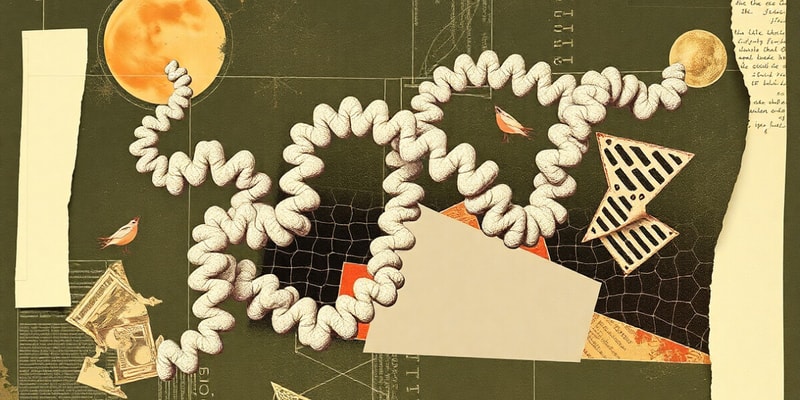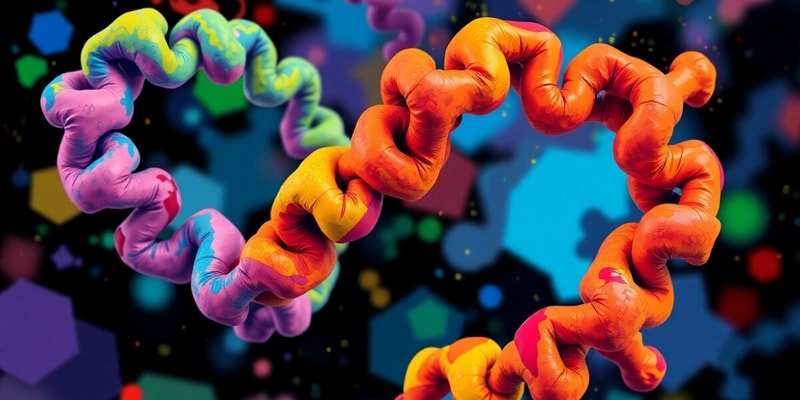Podcast Beta
Questions and Answers
What is the structural significance of the tetrahedral geometry of the $\alpha$-carbon in peptide bonds?
What characterizes parallel beta sheets compared to antiparallel beta sheets?
In which positions of beta turns are Glycine and Proline most commonly found?
What type of hydrogen bonds are formed in antiparallel beta sheets?
Signup and view all the answers
What is the role of beta turns in protein structure?
Signup and view all the answers
What is the primary difference between configuration and conformation in proteins?
Signup and view all the answers
Which of the following interactions does NOT typically stabilize protein folding?
Signup and view all the answers
What role does the hydrophobic effect play in protein folding?
Signup and view all the answers
Which level of protein structure is directly responsible for the specific three-dimensional conformation necessary for biological function?
Signup and view all the answers
How do hydrogen bonds contribute to protein structure?
Signup and view all the answers
What is the significance of the 'native fold' in proteins?
Signup and view all the answers
In the context of protein folding, what is the relationship defined by the equation ΔG = ΔH - TΔS?
Signup and view all the answers
What kind of interactions are described as 'salt bridges' in proteins?
Signup and view all the answers
What describes the overall 3D arrangement of all atoms in a protein?
Signup and view all the answers
Which type of bond helps stabilize the quaternary structure of fibrous proteins like α-keratin?
Signup and view all the answers
In relation to protein structure, what constitutes quaternary structure?
Signup and view all the answers
Which of the following is NOT a characteristic of fibrous proteins?
Signup and view all the answers
How do long-range interactions between amino acids contribute to protein tertiary structure?
Signup and view all the answers
Which factor is NOT a cause of protein denaturation?
Signup and view all the answers
The process of returning a protein to its native conformation after denaturation is known as what?
Signup and view all the answers
Which of the following diseases is associated with protein misfolding and aggregation?
Signup and view all the answers
What role do chaperonins play in protein biology?
Signup and view all the answers
Which structure is NOT considered a level of protein structure?
Signup and view all the answers
What is the primary amino acid composition of collagen?
Signup and view all the answers
Which structural element is characteristic of the protein myoglobin?
Signup and view all the answers
What is the role of vitamin C in collagen synthesis?
Signup and view all the answers
Which of the following proteins has the highest proportion of α-helical structure?
Signup and view all the answers
What type of bonding is primarily responsible for the cross-linking in collagen fibrils?
Signup and view all the answers
How does the presence of water affect the iron (Fe) component of myoglobin?
Signup and view all the answers
What is the significance of the left-handed helix structure in collagen?
Signup and view all the answers
Which protein has a total of 124 amino acids and a significant proportion of β-conformation?
Signup and view all the answers
Study Notes
Protein Structure
- Configuration: The fixed 3D relationship of atoms in a molecule, determined by the bonds between them.
- Conformation: The spatial arrangements atoms in a molecule can adopt, freely converting between them through rotation around single bonds.
- Native Fold: The specific 3D conformation a protein adopts that allows it to perform its biological function.
- Favorable Interactions: The native fold maximizes favorable interactions within the protein like hydrophobic effect, hydrogen bonds, electrostatic interactions, and covalent bonds.
Interactions Influencing Folding
- Hydrophobic Effect: Nonpolar residues cluster together, releasing water molecules from their solvation layer and increasing entropy.
- Hydrogen Bonds: Interactions between N-H and C=O groups in peptide bonds contribute to the stability of the fold and lead to secondary structures like α-helices and β-sheets.
- Electrostatic Interactions: Strong interactions between permanently charged groups, especially when buried in a hydrophobic environment, stabilize the protein.
- Covalent Bonds: Disulfide bonds between cysteine residues contribute to protein stability.
Levels of Protein Structure
- Primary Structure: The linear sequence of amino acids in a polypeptide chain.
-
Secondary Structure: Local, regular structures formed by hydrogen bonding between backbone atoms.
- α-Helices: Spiral shape stabilized by hydrogen bonding between backbone atoms.
- β-Sheets: Flat, sheet-like structure stabilized by hydrogen bonding between different polypeptide strands.
- Tertiary Structure: The overall 3D arrangement of all atoms in a protein. Includes interactions between amino acids that are far apart in the sequence.
- Quaternary Structure: The arrangement of multiple polypeptide subunits in a protein complex.
Fibrous Proteins
- Structure: Long, extended, and usually consist mainly of a single type of secondary structure.
- Function: Structural role in organisms.
- Examples: α-keratin, collagen, silk fibroin.
α-Keratin
- Function: Strength, found in hair, wool, nails, claws, horns, etc.
- Structure: Two α-helices twist to form a coiled coil; further assemble into protofilaments and protofibrils, stabilized by disulfide bonds.
Collagen
- Function: Strength and flexibility in connective tissue, cartilage, tendons, bone, cornea, etc.
- Structure: Three left-handed helices, usually with a Gly-Pro-4OH-Pro repeat, twist around each other in a unique tertiary and quaternary structure.
- Modification: Proline hydroxylation requires vitamin C.
- Cross-linking: Imine bonds between modified lysine residues create strong connections in collagen fibrils.
Globular Proteins
- Structure: Compact, rounded shapes, often with multiple types of secondary structures.
- Function: Diverse functions, including enzymes, transport, and signaling.
Myoglobin
- Function: Oxygen storage in muscle tissue.
- Structure: Single polypeptide chain with 8 α-helices and a heme group that binds oxygen via iron.
Chaperonins
- Function: Assist in the proper folding of proteins.
Protein Misfolding and Aggregation
- Misfolding: Can trigger aggregation of proteins into amyloid fibrils.
- Disease Implications: Amyloid fibril accumulation is associated with Alzheimer's, Parkinson's, and diabetes.
Protein Denaturation
- Definition: Loss of protein structure, resulting in loss of function.
- Causes: Heat, extreme pH, solvents, detergents, and specific solutes like urea and guanidine hydrochloride.
Protein Renaturation
- Definition: The process whereby denatured proteins regain their native conformation.
- Implication: Demonstrates that the tertiary structure of proteins is encoded in their amino acid sequence.
Protein Folding
- Process: The complex and dynamic process by which polypeptide chains fold into their correct three-dimensional conformation.
- Assisted Folding: Chaperonins and other molecular chaperones can help facilitate proper protein folding.
Studying That Suits You
Use AI to generate personalized quizzes and flashcards to suit your learning preferences.
Related Documents
Description
Explore the essential concepts of protein structure, including configuration, conformation, and native fold. This quiz delves into the interactions that influence protein folding, such as hydrophobic effects, hydrogen bonds, and electrostatic interactions, providing a comprehensive understanding of molecular biology.



